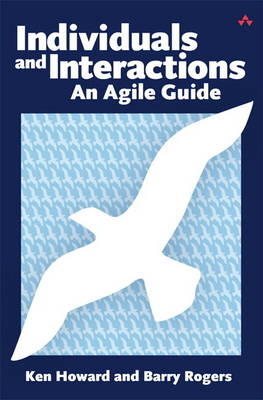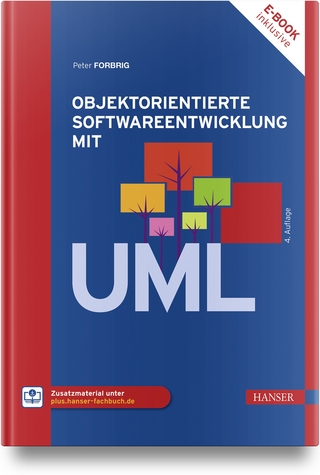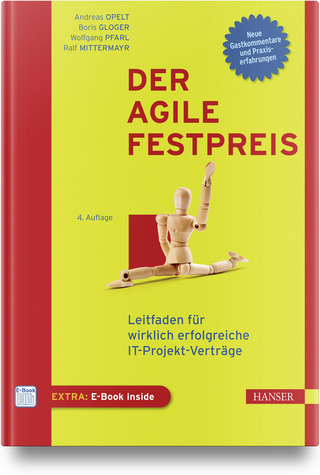
Individuals and Interactions
Addison-Wesley Educational Publishers Inc (Verlag)
978-0-321-71409-1 (ISBN)
- Titel ist leider vergriffen;
keine Neuauflage - Artikel merken
--Sarah Edrie, Director of Quality Engineering, Harvard Business School
“Cloud Computing, Distributed Architecture, Test Driven Development...these are simple to master compared to building an agile, efficient, and top-performing team. The path from skilled developer/tester to successful manager, team leader, and beyond is now more easily attainable with the insights, knowledge, and guidance provided by Ken Howard and Barry Rogers in Individuals and Interactions: An Agile Guide.”
--R.L. Bogetti, www.RLBogetti.com, Lead System Designer, Baxter Healthcare
“This book provides fantastic insight on how individuals act and relate as a team. Ken and Barry give great examples and exercises to help the reader understand behaviors of each individual and use this knowledge to perform better as a team.”
--Lisa Shoop, Director Product Development, Sabre-Holdings
“Individuals and Interactions is a masterfully crafted must-read for anyone who is serious about understanding and applying the human-centered values of Agile development. It is like Patrick Lencioni meets the Poppendiecks to write ‘Agile through the Looking-Glass.’ Here the ‘Looking-Glass’ is the powerful DISC framework, and we see it used to enable different kind of TDD (Team-Driven Development) through the use of stories, examples, models, and guidance.”
--Brad Appleton, Agile coach/consultant in a Fortune 100 telecom company; coauthor of Software Configuration Management Patterns
“This book is essential reading for any engineering team that’s serious about Agile development. Its chapters on team dynamics and development lay the foundation for learning all of the factors that enable a team to transform itself into an Agile success story.”
--Bernard Farrell, Consultant Software Engineer at EMC Corporation
Great emphasis is typically placed on the “mechanics” of agile development--its processes and tools. It’s easy to forget that the Agile Manifesto values individuals and interactions ahead of processes and tools. You can gain powerful benefits by refocusing on the people side of agile development.
This book will show you how. It’s your practical user’s guide to solving the problems agile teams encounter, packed with stories, best practices, exercises, and tips you can actually use. Step by step, you’ll learn how to get teams to truly work as teams, not as disconnected individuals. Along the way, you’ll find profoundly realistic advice on communication, motivation, collaboration, change, group dynamics, and much more.
Whether you are an agile project manager, ScrumMaster, product owner, developer, trainer, or consultant, this book will help you make your agile environment more productive, more effective, and more personally fulfilling.
Ken Howard works at Improving Enterprises, where he specializes in helping companies increase productivity through efficient practices and pragmatic organizational dynamics. Ken has been involved in most aspects of software development for more than 26 years with such languages as diverse as COBOL, Smalltalk, and Java. Over the years Ken has provided consulting, training, and mentoring to companies in 12 countries around the world, helping with adoption of software development best practices. He eagerly embraced the opportunity to share many of the things he has learned with a broader audience through the publication of this book. Barry Rogers is President of Improving Enterprises, Dallas, Texas. He is an accomplished Certified ScrumMaster and Certified Scrum Practitioner. Barry supports clients in both a hands-on and mentorship/coaching capacity, helping teams adopt agile/Scrum and improve human dynamics. Barry is a Speaker and also facilitates leadership, agile, and project management training sessions.
Preface xv
Introduction 1
A Brief History of Organizational Behavior 2
Stage 1: People Are Machines (Late 1800s—Mid 1900s) 2
Stage 2: People Are Emotional Beings (1940s—1970s) 3
Stage 3: Organization Is a Machine (1980s—2000s) 4
Stage 4: Empowered Teams Transform the Organization (Current Trend) 6
Birds of a Feather... 6
PART I: INDIVIDUALS AND INTERACTIONS
Chapter 1 Autonomous Securities, LLC 11
Chapter 2 Behavior and Individuals 13
Communication Framework 14
DISC History 15
DISC Definition 15
So Why Is This Important? 17
Understanding and Accepting Others 17
Communicate in Your Own Language 19
The Language of DISC 20
Strategies for Communicating 21
How Do You Take a DISC Assessment? 22
Closing 23
Chapter 3 Team Dynamics 25
An Apoplectic Dilemma 25
A Different Approach to Teams 26
Capitalizing on Strengths 28
The Anarchical Team 30
The Evolution of a Maturing Team 30
Conflict 33
Now What? 40
Closing 42
Chapter 4 Communication 43
Lingo 45
Empathy 46
Eye Contact 48
Ambiguity 49
Body Language 50
Cultural Awareness 53
Reflecting Body Language 54
Small Talk 54
Collaborative Conversations 57
The Power of Shutting Up 64
Communication Latency 65
We the People... 68
Closing 69
Chapter 5 Collaboration 73
Working as a Team 73
Vox Populi 74
Group Survival 77
Problem-Solving Versus Decision Making 78
Individuals and Decisions 79
Groups and Decisions 79
Group Influence 80
Six Degrees of the Perfect Ice Cream Sundae 83
Diametrically Opposing Forces 85
Closing 88
Chapter 6 Behavior and Teams 89
Harmony/Conflict 89
Why Not Hire a Team with Members That Will All Naturally Get Along? 92
Be Prepared for Conflict 93
Stressed Out 94
Fill the Gaps 94
Organizational or Team Culture 95
Closing 95
Chapter 7 Change 97
A True Story 97
Why Is Change Difficult? 99
Change Squirm 102
Change Apprehension 103
Fear of Changes to Self-Actualization Needs 104
Fear of Changes to Esteem Needs 105
Fear of Changes to Love/Belonging Needs 105
Fear of Changes to Safety Needs 106
Fear of Changes to Physiological Needs 106
Change Coach 107
Change Catalyst 108
Tracing to the Roots 109
Grass Roots Resistance to Change 110
Exposing the Origins 111
Exercise 113
Closing 114
Chapter 8 Motivators 115
Individual Workplace Motivators 115
Theoretical 116
Utilitarian/Economic 116
Aesthetic 117
Social 117
Individualistic/Political 117
Traditional/Regulatory 117
Why Is This Important? 118
Strategies for Motivating 119
Leveraging Strengths 122
Leadership and Environment 123
Closing 124
PART II: WORKSHOP
Chapter 9 Team Dynamics Workshop 129
Preparation 129
Workshop Instructions 130
Pre-Workshop 130
The Workshop 132
Chapter 10 Communication Origami 139
Materials 140
Setup 140
Facilitation 141
Post-Exercise Discussion 141
Chapter 11 Bridge Building 145
Materials 146
Setup 146
Facilitation 147
Post-Exercise Discussion 148
Chapter 12 Moon Survival 151
Setup 152
Facilitation 152
Individual Exercise 152
Team Exercise 153
Scoring 153
Post-Exercise Discussion 153
Moon Survival Expert Analysis 158
Chapter 13 BalderDISC 163
Materials 164
Setup 164
Facilitation 165
Post-Exercise Discussion 166
Chapter 14 Assessing Concordance and Discordance 169
Materials 169
Setup 170
Facilitation 170
Post-Exercise Discussion 171
Chapter 15 Change Exercise 175
Overview 175
Setup 176
The Drawing Board 177
The Teams 177
Facilitation 178
Post-Exercise Discussion 179
Chapter 16 Groups and Decisions 183
Setup 183
DISC-Homogeneous Behavior 185
Appendix How to Take the DISC 187
References 195
Index 199
| Verlagsort | New Jersey |
|---|---|
| Sprache | englisch |
| Maße | 154 x 232 mm |
| Gewicht | 383 g |
| Themenwelt | Informatik ► Software Entwicklung ► Agile Software Entwicklung |
| ISBN-10 | 0-321-71409-1 / 0321714091 |
| ISBN-13 | 978-0-321-71409-1 / 9780321714091 |
| Zustand | Neuware |
| Haben Sie eine Frage zum Produkt? |
aus dem Bereich


